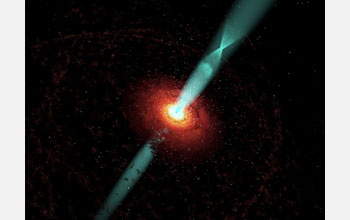News Release 08-067
Catching a Glimpse of a Black Hole's Fury
New telescope evidence suggests twisted magnetic fields in supermassive black holes cause particle and energy jets to surge out in corkscrews
April 23, 2008
This material is available primarily for archival purposes. Telephone numbers or other contact information may be out of date; please see current contact information at media contacts.
Using the National Science Foundation's (NSF) Very Long Baseline Array (VLBA) and a host of international telescope partners, a team of researchers has made the clearest observation yet of innermost region of a black hole.
From the observations, astronomers found strong evidence that the enormous jets of particles emitted by supermassive black holes are corkscrewed in a way predicted by theory. The researchers believe the coiling is a result of twisted magnetic fields acting on the particle streams.
The researchers reported their findings in the April 24 issue of Nature.
Led by Alan Marscher of Boston University, the international team of researchers studied the galaxy BL Lacertae located 950 million light years from Earth. By observing an outburst from the galaxy from late 2005 to 2006, the team observed bursts of photons oriented in a way predicted by theories about the twisted magnetic fields of black holes.
The VLBA is part of NSF's National Radio Astronomy Observatory (NRAO). A more detailed release--including graphics and a broadcast-quality animation--is available from NRAO at: http://www.nrao.edu/pr/2008/bllac
Additional images, explanations, data sets and even a related song are available at a Web site posted by Marscher: http://www.bu.edu/blazars/BLLac.html
-NSF-
Media Contacts
Joshua A. Chamot, NSF, (703) 292-7730, email: jchamot@nsf.gov
Dave Finley, NRAO, (575) 835-7302, email: dfinley@nrao.edu
Program Contacts
Vernon L. Pankonin, NSF, (703) 292-4902, email: vpankoni@nsf.gov
Principal Investigators
Alan Marscher, Boston University, (617) 353-5029, email: marscher@bu.edu
The U.S. National Science Foundation propels the nation forward by advancing fundamental research in all fields of science and engineering. NSF supports research and people by providing facilities, instruments and funding to support their ingenuity and sustain the U.S. as a global leader in research and innovation. With a fiscal year 2023 budget of $9.5 billion, NSF funds reach all 50 states through grants to nearly 2,000 colleges, universities and institutions. Each year, NSF receives more than 40,000 competitive proposals and makes about 11,000 new awards. Those awards include support for cooperative research with industry, Arctic and Antarctic research and operations, and U.S. participation in international scientific efforts.
Connect with us online
NSF website: nsf.gov
NSF News: nsf.gov/news
For News Media: nsf.gov/news/newsroom
Statistics: nsf.gov/statistics/
Awards database: nsf.gov/awardsearch/
Follow us on social
Twitter: twitter.com/NSF
Facebook: facebook.com/US.NSF
Instagram: instagram.com/nsfgov

